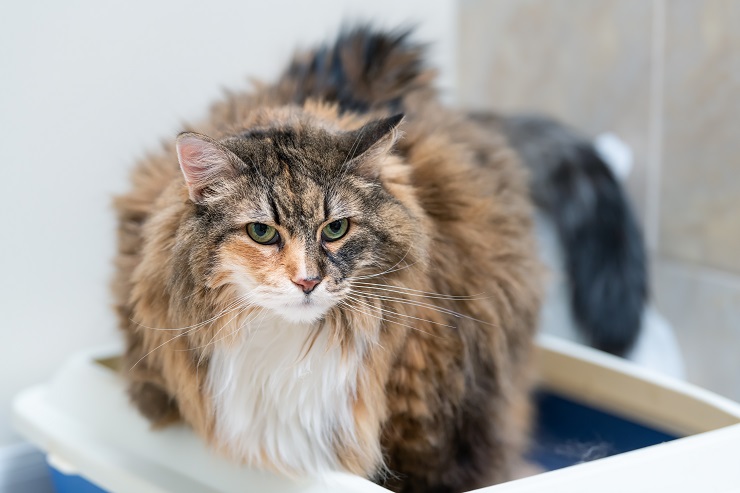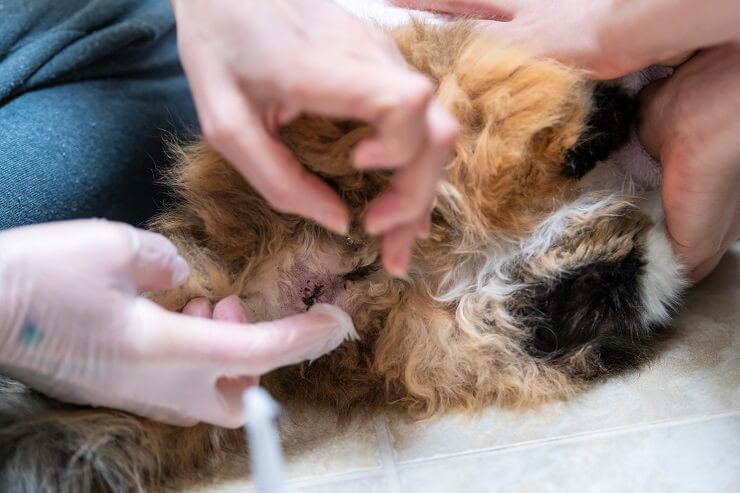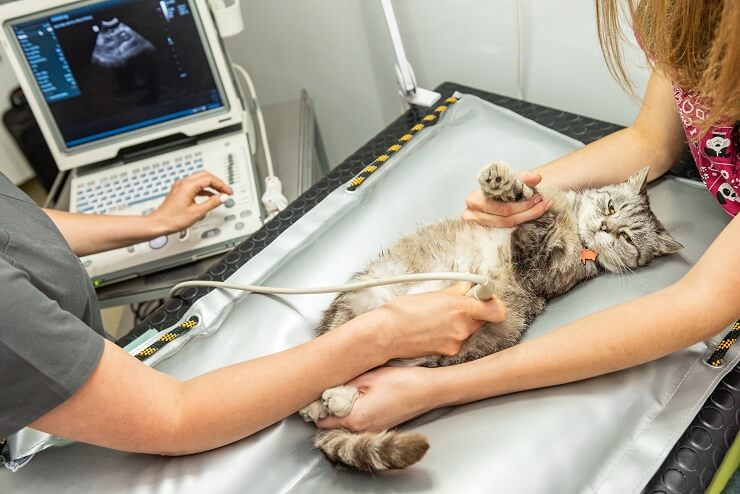
This article aims to explain the details of megacolon in cats, a common issue. This is a simple, clear explanation about the condition for pet owners.
What Is Megacolon?
Megacolon is a condition where the lower part of the digestive tract (the colon) becomes grossly enlarged, full of a large amount of fecal material that the cat is unable to pass. “Mega” means “enlarged” and “colon” is the name of the part of the digestive tract that’s affected by this dilation (widening) and dysfunction.
The gastrointestinal tract consists of the stomach, small intestine and large intestine. The large intestine is then divided into the colon, the rectum and the anus, which is where feces emerges. So the enlarged area in megacolon is the colon, between the small intestine and the rectum. This is the area of intestine in front of the pelvic canal.
Megacolon is a type of severe constipation (also known as obstipation) where the feces cannot be passed at all, and it accumulates in the colon, causing it to become over-full with a solid mass of fecal material.
When the colonic smooth muscle is overstretched for a period of time, it becomes floppy, like a balloon that has been inflated then deflated, and colonic motility is dramatically reduced. This removes the ability of the colon to push feces along in the normal way, causing an even greater retention of feces and impaction, which further dilates and damages the colon.
Megacolon is commonly seen in small animal veterinary practice, where it’s most often seen in cats, and less often seen in dogs.
How Common Is Megacolon?
Megacolon is a common condition in cats, especially in middle-aged animals (the average age is around six years of age). Male cats are more likely to suffer from this, making up 70% of cases, compared to 30% in female cats.
This is seen most commonly in domestic short-haired cats, but it’s also seen in domestic long-haired cats, and it’s seen in Siamese cats more than in other pedigree breeds.
How Do Cats Get Megacolon?
Megacolon has several possible causes, in order of incidence as follows:
- Idiopathic megacolon (i.e. the cause cannot be identified) 62%
- Pelvic canal narrowing (e.g. after a road accident) 23%
- Nerve injury (e.g. spinal disease) 6%
- Congenital spinal cord deformity (e.g. Manx cats) 5%
- Other causes include mechanical obstruction (e.g. intestinal tumors, strictures of the bowel, and rarely, long-term obstructions caused by foreign bodies.)
Symptoms of Megacolon in Cats

Symptoms of megacolon are very similar to those of constipation and usually include reduced or absent defecation, pain on passing feces, straining as if trying to pass feces, etc.
Chronic constipation is the best way to describe the symptoms of megacolon. The main clinical signs noticed by owners are usually linked to the behavior of the affected cats around defecation.
- Reduced or absent defecation
- Pain on passing feces
- Straining as if trying to pass feces (so-called tenesmus), but nothing being passed
- Dullness
- Swollen abdomen
- Painful abdomen
- Vomiting
- Inappetence
- The presence of blood or mucus at the anus
- Sometimes a hard swelling can be felt on palpation of the abdomen
- Longer term, weight loss may be noted
Causes of Megacolon in Cats
In nearly two thirds of cases (62%), the cause cannot be identified, and such cases are classified as “idiopathic”. Nearly one in four cases (23%) are caused by narrowing of the pelvic canal (such as after pelvic fractures in a road accident) which causes a partial obstruction, then leading to megacolon.
Around one in twenty cases (6%) are caused by disruption of the nerve supply to the colon, such as spinal cord injury. Another one in twenty (5%) are caused by a congenital abnormality of the anatomy of the region. There are also other, rarer causes.
Diagnosis of Megacolon
If your DVM veterinarian suspects that your cat may have megacolon, the following steps may be taken. As well as confirming the diagnosis, it’s important to identify the underlying cause so that the most appropriate treatment can be given.
1. Detailed History Taking
Your vet will discuss every aspect of your cat’s condition and overall health care, with a particular focus on a discussion of your pet’s bowel movements.
There are other conditions that can cause similar signs as megacolon, and this history will help to determine precisely what’s going on. If you can take video footage of your cat attempting to pass feces, this may be helpful.
2. Physical Examination
Your veterinarian will check your cat over carefully, and in particular, they will carefully palpate your cat’s abdomen. A hard, tubular-like mass can usually be felt, representing the colon full of hard feces.
Signs of dehydration may be seen, and on rectal examination with a gloved finger, narrowing of the pelvic canal may be noted (e.g. old pelvic fracture).
3. Routine Laboratory Tests
It’s very likely that your veterinarian may carry out blood work, including the usual panel of diagnostic tests, such as hematology (blood count) and biochemistry profiles.
In an uncomplicated case of megacolon, these blood tests will usually be normal, although they can be useful in determining your cat’s hydrations status. A metabolic profile may include electrolyte assays.
Urinalysis may be carried out as part of a general review of your cat’s health.
4. Diagnostic Imaging
Radiography (x-rays) is usually carried out: this will clearly show the degree of megacolon, with accumulated feces easily visible in the ascending, transverse and descending colon. Radiographs will also allow bony structures to be evaluated, including the width of the pelvic canal and the presence of spinal disease.
Images will also be screened for any evidence of neoplasia (tumors) that could be causing a partial obstruction of the digestive tract which could cause megacolon.
Ultrasound may also be used, for better evaluation of soft tissue structures around the megacolon.
Advanced imaging (such as CT or MRI scans) may rarely be recommended if detailed analysis of specific areas is needed.
Occasionally, colonoscopy may be used to visually inspect the interior of the colon.
Treatment of Megacolon

Megacolon is usually treated with medications (laxatives, stool softeners, colon wall stimulants and high fiber diets), and ultimately surgery.
- The primary treatment is the immediate removal of the accumulation of feces in the colon, which may involve repeated enemas and manual removal of feces, often under sedation or general anesthesia.
- Correction of dehydration with intravenous fluid therapy is often needed to facilitate the passage of feces: the more dehydrated the cat is, the more solid, dry, and hard the impacted feces will be.
- Once the impacted feces has been removed, the goal of therapy is to take measures to prevent the feces from accumulating again.
- Low-residue, prescription-only diets are often recommended
- High fiber diets and fecal bulking agents may sometimes be suggested
- Prescription medications may be recommended to increase the motility of the colon (so-called prokinetic products), including drugs such as cisapride and others. These are powerful, prescription only drugs and should only ever be used on specific instructions from your veterinarian.
- Other medications may be recommended to lubricate the feces, such as laxatives (e.g. oral liquid paraffin), or stool softeners such as lactulose, which remains inert until it reaches the colon, when it draws fluid into the colon, adding fluid to the feces.
- In extreme cases where medical management is not sufficient to relieve the obstruction , or when it keeps recurring despite medical therapy, surgical treatment to remove the enlarged colon (total or sub-total colectomy) may be recommended.
Monitoring and Prognosis
Megacolon often recurs, so monitoring your cat’s litterbox habits is important. This will allow you to identify any recurrence at the earliest stage possible (i.e. if your cat stops passing feces regularly, or if they have difficulty passing feces). Early treatment of the problem is more likely to be effective.
Physical rechecks by your veterinarian to palpate the abdomen are also important, and if in doubt, repeated radiographs may be taken to monitor the size of the colon.
Megacolon is a serious disease affecting cats, highlighting the need for cat carers to monitor their pets’ litter box habits every day, so that any changes in their defecation habits can be quickly identified. Prompt veterinary care is important if a cat does develop signs of megacolon.
Frequently Asked Questions
What are the symptoms of megacolon in cats?
A cat with megacolon will strain when trying to pass feces, but will usually pass very little, or nothing at all, despite great effort. A trace of blood and mucus may be seen at the anus. The cat may have a swollen abdomen, and may be dull, and unwilling to eat. They should be taken to your veterinarian without delay.
How do you treat megacolon in cats?
You need to take your cat to the vet. First, intensive treatment is needed to clear out the impacted colon, and then medical and dietary treatment is usually given. If this is not successful, surgical options are available.
What do you feed a cat with megacolon?
There are different theories, and you should discuss this in detail with the veterinarian treating your cat. The two most common recommendations are:
Low-residue, prescription-only diets that produce a very small amount of feces
Higher fiber diets, that produce bulkier but less dense fecal material that's less likely to become impacted
How much does it cost to treat a cat with megacolon?
It is impossible to estimate this cost, as there are so many different possible factors in each case. You should always ask your veterinarian for a detailed estimate before agreeing to proceed with any treatment. Costs could vary from $400 for a simple case to $6000 or more for an exceptionally complex case of megacolon requiring surgical intervention such as colectomy.
What can cause megacolon in cats?
In most cases (62%), the cause of megacolon in cats is unknown. The next most common cause is damage to the pelvis, causing narrowing of the pelvic canal (e.g. after a road accident). Other causes include problems with the nerve supply to the colon, a congenital spinal abnormality in some cats, and rarely, mechanical obstruction caused by intestinal tumors, foreign objects etc.
How do I know if my cat has megacolon?
The main signs, as listed above, are difficulty passing feces (straining unproductively, often with discomfort, in the litter box), as well as dullness and inappetence. Sometimes a swollen abdomen is noted, and other signs include dehydration, vomiting, and blood or mucus at the anus.
Is megacolon fatal in cats?
Most cats do survive, but cats treated medically tend to suffer recurrences that need ongoing treatment, and sometimes the issue becomes increasingly difficult to treat effectively. Cats treated with surgery are more likely to achieve complete remission with no recurrence.
Is cat megacolon contagious to other cats?
No. Megacolon is not caused by an infectious agent, so it will not spread from cat to cat.
How serious is megacolon in cats?
This can be a very serious and life threatening disease, requiring urgent veterinary treatment.








My cat has been diagnosed with mega colon and is not doing well. He has been on meds for several months now and special diet. He is at the point where he is no longer eating and has lost over 10 pounds. He was overweight at 28 pounds and is now down to 16. He sleeps most of the day now and is just not the cat he was. I feel he may be suffering. He is only 7 and I am hesitant to euthanize him at this point. How will I know when it is time for this? My husband feels he has no quality of life and my vet will not say either way. I guess she wants me to make the decision on my own. Do you have any thoughts that can help me know the right thing to do. It is hard for me to look at him as I do feel in my heart that he is suffering. Thank you.
I’m so sorry, Frances, that sounds like a heartbreaking situation. It’s good that your vet is leaving the decision up to you but I’m a little surprised they won’t say anything on the matter. Has your vet made any comments about the state of your cat’s health? Has it declined significantly even with the medications? Is his health improving with treatment or has there been no change?
It’s difficult to tell exactly how our cats are feeling. One possibility is that the special diet just isn’t cutting it for him. What kind of food is it? If he’s extremely lethargic, it’s possible that he’s not getting enough calories. At 16 pounds now, he’s definitely at a healthier weight, but how quickly did he lose it? Rapid weight loss like that can be stressful on a cat’s body and if he’s not eating he might be malnourished.
Ask your vet some of these questions to see what they say. I’d also recommend you try tempting your kitty with some meaty, flavorful wet foods to see if you can get him to eat. If he accepts these foods it might just be that he no longer likes the special diet. Give it a week or two of trying different recipes to see whether that’s the case and to see whether he starts to feel better.
You know your kitty best, however, and it’s always a heartbreaking decision to let our kitties go. If you’re not quite ready to make the decision or you just want to be sure you’ve done everything you can up to that point, try some of these things. Best of luck to you and your family!
Thank you for this informative article about megacolon. My Siamese has been going through difficult times in eliminating feces. I’ve taken her to the vet and she has been put on a special diet with more fiber and lactulose and she is doing better.
Thanks again.
Ellen
Thank you for stopping by, Ellen!